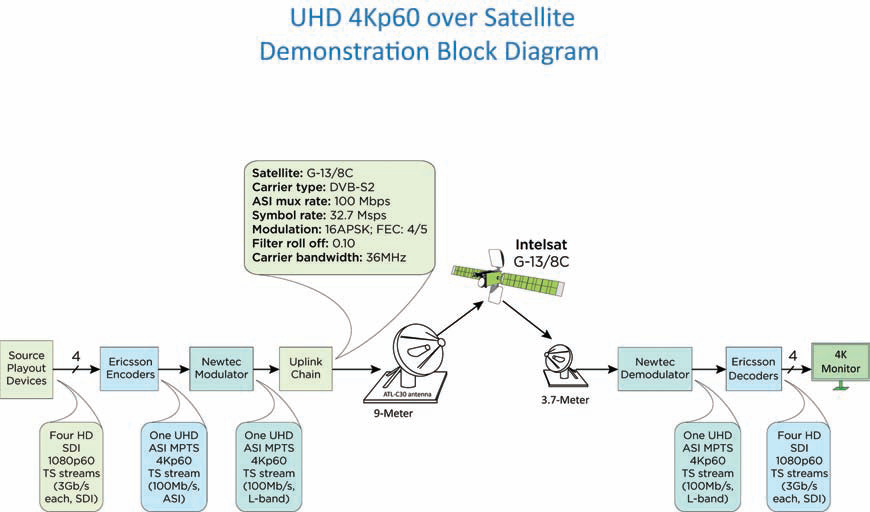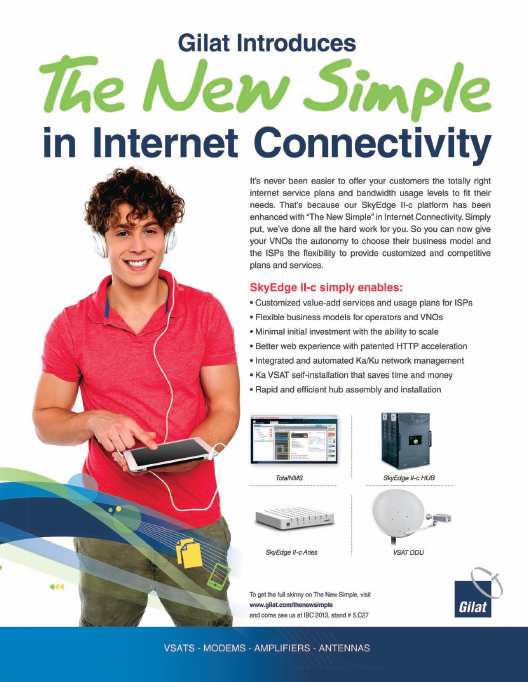A recent, successful demonstration of 4K Ultra High Definition (UHD) delivery shows that Intelsat is capable of delivering the higher quality signals to consumers using transponders that are in service today. However, to take advantage of this potential opportunity, the broadcast sector must avoid repeating some of the mistakes that led to customer backlash against 3D and the subsequent shutdown of several, high-profile 3D channels.

4K UHD is the next evolutionary step for television broadcasting. Just as Intelsat supported the smooth transition from SD to HD, so, too, will the company be ready to support the transition to full-time distribution in this new format. In June, Intelsat and Ericsson demonstrated true 4K, end-to-end video transmission via satellite. This was the first transmission of a UHD signal over satellite in North America, and the demonstration proves that the satellite delivery chain can accommodate the next-generation signals as soon as broadcasters are ready to offer them.
The demonstration delivered a 4:2:2 10-bit, 4K UHD signal at 60 frames per second, or p60, to Turner Broadcasting’s facilities in Atlanta, Georgia. This transmission of a live-encoded 4K UHD signal over satellite in North America was achieved using Intelsat’s Galaxy 13. The 100 Mbps video feed was encoded and decoded in real time by Ericsson using its AVP 2000 contribution encoders and RX8200 receivers. Newtec provided the modulation and demodulation hardware, featuring Clean Channel Technology®, and the satellite downlink antenna was provided by Turner Broadcasting.
The 36MHz transponder, typical for C-band distribution, allowed us to increase the transmission rate to 100 megabits per second. There were two tests—one to see maximum throughput on a 36MHz transponder, in which we achieved 140Mbps, and one for a 100Mbps data rate, which is optimal for the 4K signal being encoded. The technical process of preparing for and transmitting a 4K UHD signal is not much different than for other high-speed transmissions; however, carrying 100Mbps on a single C-band transponder demonstrates that the satellite ecosystem is innovating to stay at the forefront of media distribution.
The transition from SD to HD took almost 10 years, so it is important to be realistic about the 4K timeline. In order to support the mainstream adoption of the technology, the entire industry must work to ensure that we have all of the right pieces and that technology does not get ahead of consumer demand.
The Popularity Of 4K/UHD Will Be Driven By Content Availability
Compared to 3D, broadcasters are viewing 4K as more compelling and customers, anecdotally speaking, seem to better appreciate this format. The migration to 4K will not be immediate. Intelsat believes 4K will enable a new premium tier of programming to be made available by selected large programmers. Not everything will be in 4K in the short term. That is in part related to cost, but it is also customer-driven. Some content simply will not work well in 4K.
Having said that, Intelsat does not believe the transition from HD to 4K will be en mass—there will be more demand for managed services. Rather than just buying a transponder, customers will want an entire transmission chain. In many instances, delivery of 4K will be over satellite and over fiber, and the Intelsat network is prepared to do both.
Ultimately, it will all start with content, and there is little content available today in 4K. If you remember the introduction of 3D television, lack of content was a huge barrier to consumer acceptance. Media companies must, therefore, make certain content is available in large quantities for consumers to watch on 4K screens and that services will be available through payTV operators.
This transition will require time and everyone will have to be patient. There have been many lessons learned from previous experiences and the company wants to get it right with 4K, as we see the tremendous potential of the technology. All parties need to work together to ensure 4K success.
Intelsat To Demonstrate Live 4K Delivery With Partners BT + Ericsson At IBC
Going forward, Intelsat plans to conduct more demonstrations with a number of broadcasters and DTH providers. As the technology improves, new elements of the delivery chain become available. Company efforts will continue to ensure the provisioning of the end-to-end delivery of the content to owners all the way to their homes.
As a pioneer of next-generation compression systems and a long-time partner, Ericsson was the obvious choice for the Atlanta demonstration. Intelsat was delighted to work with them on this project, and believe that the mutual cooperation enables Intelsat to lead the way for UHD TV over satellite. The two companies have a wealth of expertise that allows broadcasters’ and programmers’ needs to be fully anticipated—the support will be present for them when they transition to UHD.
Intelsat will offer a demonstration at IBC that will include live content and more partners at booth 1.C71 where visitors can experience 4K broadcasting via satellite.

About the author
Peter Ostapiuk is responsible for management and development of Intelsat’s media products portfolio. He manages a global team of marketing and product-management professionals that is responsible for management of media satellite neighborhoods and managed IntelsatOne video services that include fiber, teleport and MCPC products. Mr. Ostapiuk is also responsible for Intelsat’s Occasional Use business and development of Intelsat EpicNG media applications. Prior to his current position, Mr. Ostapiuk served as Regional Vice President, Sales where he managed Intelsat’s sales efforts for its North America Media products and services. Those efforts targeted broadcasters, cable programmers, value-added resellers and service providers, DTH platforms and IPTV customers, as well as other emerging media sectors. Mr. Ostapiuk has 20 years of experience as a sales professional, including 17 years in the telecommunications and satellite industries. Prior to joining Intelsat in October 2008, he held a range of international and domestic sales-management roles with Cisco, Scientific-Atlanta and EchoStar International.


